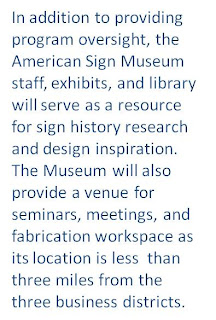 So, we built the storefronts, and we're installing our signs from yesteryear, but something was missing on Main Street. You know, those details that would bring a streetscape to life. One phone call to friends David and Suzie Butler, and they were on it. Now, as I'm writing this, a team of 27 veteran sign painters - most of them longtime friends - from across the U.S. and Canada are here for the week and busy filling in the blank spaces that will make all the difference in your Signs on Main Street Experience.
So, we built the storefronts, and we're installing our signs from yesteryear, but something was missing on Main Street. You know, those details that would bring a streetscape to life. One phone call to friends David and Suzie Butler, and they were on it. Now, as I'm writing this, a team of 27 veteran sign painters - most of them longtime friends - from across the U.S. and Canada are here for the week and busy filling in the blank spaces that will make all the difference in your Signs on Main Street Experience. Project leaders each took on a particular storefront or wall and had their designs ready when they arrived so they could hit the ground running Monday morning. But anticipation was high, and most went straight to the museum from the airport on Saturday! And everyone was on hand to get started first thing Sunday!
For our Facebook fans, here an image of the Dulaney's storefront design.
Watching them work is a truly a sight to behold, and as soon as we have some breathing room, we plan to post more info and images for all to see. Here are just a few images to show the breadth of talent (we're estimating the team represents about 1,000 YEARS experience) these folks bring. And this is just 3 days' worth! Much more to come!
Again, this is just a sampling of the last few days, with much more to come. Hope to see you when we open in June!




















